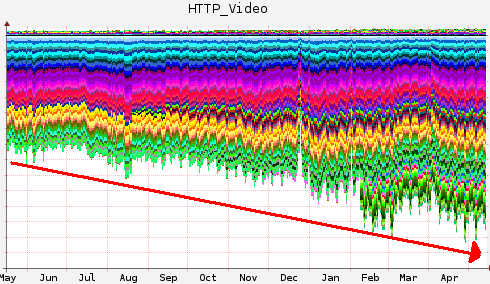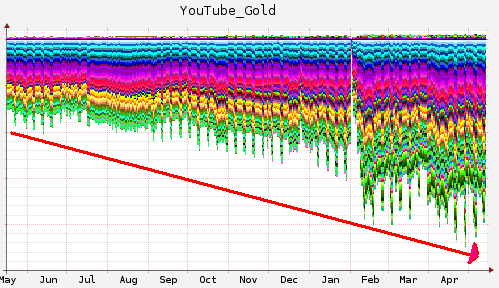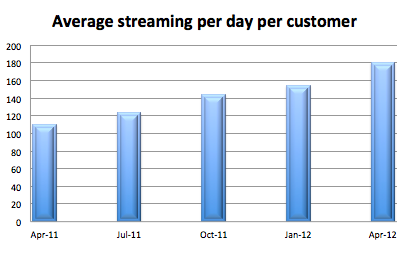Linear TV is so 2011...On-Demand and Streaming is the Future
- Subscribe to RSS Feed
- Mark as New
- Mark as Read
- Bookmark
- Subscribe
- Printer Friendly Page
- Report to Moderator
- Plusnet Community
- :
- Plusnet Blogs
- :
- Linear TV is so 2011...On-Demand and Streaming is ...
Linear TV is so 2011...On-Demand and Streaming is the Future
 How we use the internet has changed - and is changing - dramatically. Ten years ago, most of the UK was on dial-up - and if you had broadband you almost certainly had a 512kbps connection. Today, 512kbps feels like a dial-up connection because the average webpage is well over 1MB. And while the average speed of broadband in the UK is now around 7-8Mbps, we’re trialling 80Mbps and even 330Mbps services. But how has this changed how we consume media - most importantly TV? Read on, for my take on it all …
How we use the internet has changed - and is changing - dramatically. Ten years ago, most of the UK was on dial-up - and if you had broadband you almost certainly had a 512kbps connection. Today, 512kbps feels like a dial-up connection because the average webpage is well over 1MB. And while the average speed of broadband in the UK is now around 7-8Mbps, we’re trialling 80Mbps and even 330Mbps services. But how has this changed how we consume media - most importantly TV? Read on, for my take on it all …
The faster speed effect - build it and they'll come
With faster speeds and superfast fibre broadband coming people often ask: "what on earth will I do with 40/80/100/330Mbps?" Right now, there aren’t a huge number of services where the average internet user needs super-fast speeds, but they’ll come. For some people the only chance of getting speeds faster than 2Mbps is through FTTC and FTTP. Lots of households are taking advantage of these services right now so multiple people can do different things online, all at the same time. In such households, for example, you could have one person watching a video on demand service (5Mbps), another watching iPlayer (3.5Mbps), a third gaming, listening to music on YouTube and chatting to friends (2Mbps) and a fourth browsing the web (low average bandwidth but with bursts up to line speed). Sustained throughput is therefore 10.5Mbps with bursts that go even higher, and they may also have downloads and software updates running in the background. So, it’s not that big a leap then to see how you start needing 40 or 80Mbps.
Devices content and demand
Faster speeds might explain how more of us are able to consume media online, but what's driving demand? The first increase in demand is down to the proliferation of internet connected devices and therefore the concurrency of usage. How long ago did the average household have a single PC connected to the internet via a USB modem? And now how many of us have phones, tablets, games consoles, set-top boxes, TVs and all sorts of other things that all connect to the internet? (One of our customers even has an IPv6 connected Cat Feeder!) The second increase is the content. People want to view content on the biggest screen they can. That used to be the (small) desktop computer screen, now it’s often the (big) TV. On a large TV, people use the highest bit rate they can to make it look the best. And of course the content providers are providing higher bit rates (all the major streaming players now offer HD streams) so that streaming services can now compete with DVDs on quality as well as convenience and cost. How long will it be before we see even higher bit-rate streams? HD satellite broadcasts are around 9-12Mbps so there’s room for an increased bit-rate for the online streams, not to mention what’s to come in the future. The streaming trends we've spotted: On an average evening, more than 50% of Plusnet customer traffic is streaming - and this peaks higher during big sporting events. Although we are starting to see streaming traffic coming from Netflix, the biggest providers by far are still free services like YouTube at nearly 15% and iPlayer at around 10% of total traffic during our peak period. We've also seen that SkyGo peaks when they have exclusive content like big football games and F1, but barely registers the rest of the time (are people sharing logins with friends who aren’t Sky customers?). 4oD, Demand 5 and ITV Player combined do roughly half the traffic of iPlayer. ITV Player is similar to SkyGo in that it has peaks for exclusive content, such as their Champions League and Euro 2012 games so far. The Manchester derby on Sky Sports beat BBC1 in the TV ratings, and this doesn’t count online viewing. This was also the biggest event we’ve seen from SkyGo but it only represented about 8% of traffic on our network during the 2nd half of the game.  YouTube seems to be very popular with the kids, we see a small spike in the morning around 7-8am but only on school days (we don’t see it at the weekend or during school holidays), and then it spikes up rapidly from around 3-4pm when the schools finish.
YouTube seems to be very popular with the kids, we see a small spike in the morning around 7-8am but only on school days (we don’t see it at the weekend or during school holidays), and then it spikes up rapidly from around 3-4pm when the schools finish. 
 iPlayer is much more centred around the evening peak and you can see clear peaks when there are popular shows on like Top Gear and Doctor Who.
iPlayer is much more centred around the evening peak and you can see clear peaks when there are popular shows on like Top Gear and Doctor Who.
The top 10:
In terms of event driven demand these currently rank as the 10 biggest events we’ve seen on the network:
Date – Event
- 13/05/2012 – Final Premier League fixtures/Spanish Grand Prix
- 30/04/2012 – Man City v Man Utd
- 13/10/2011 – Release of iOS5
- 22/04/2012 – Man Utd v Everton/Bahrain Grand Prix
- 24/04/2012 – Barcelona v Chelsea
- 22/01/2012 – Arsenal v Man Utd
- 04/03/2012 – Spurs v Man Utd
- 11/02/2012 – Man Utd v Liverpool
- 05/02/2012 – Chelsea v Man Utd
- 22/01/2012 – Man City v Spurs
 Apart from the release of iOS5 and the Spanish/Bahrain Grand Prix, all of these are football games and most feature Manchester United or Manchester City (or both). To be clear, we can only see the type of traffic and time and are making the assumption about what people are doing.
Apart from the release of iOS5 and the Spanish/Bahrain Grand Prix, all of these are football games and most feature Manchester United or Manchester City (or both). To be clear, we can only see the type of traffic and time and are making the assumption about what people are doing.
Streaming Music
Streaming services are now dominating the bandwidth landscape; we now have a streaming chart and more music is streamed than downloaded. People are no longer tied to physically owning the music or videos they want to consume. In the 60s if you wanted to listen to music your choice was record or radio, the 80s added cassettes and then CDs and the 90 and 00s have brought us mp3s and the iPod. But ultimately you either had to either decide what you wanted to listen to before you went out or listen to the songs the DJ chose on the radio. Now you can take your iPhone out with you and with a service like Spotify stream any of millions of songs over 3G or wifi. Spotify uses over 1% of our network bandwidth so is clearly popular, and from talking to people we believe that a lot of the YouTube usage is from people, often their kids, creating music playlists to listen to and watch something else or play a game at the same time. This is particularly interesting because the video content being sent along with the music is effectively being ignored, despite it being the majority of the bandwidth of the stream.
Streaming Sport
Three of the top four events were only in the last 3 months. Right now we are in the middle of the summer of sport, first with Euro 2012 then Wimbledon - and we all know what’s just days away where we expect to see lots of records set.
The snake in the mailbox?
Is this the snake in the mailbox moment? Has streaming already become the new radio? And is it becoming the new way to consume TV? If content is there then people will listen or watch, especially if the price is right, (free 4oD and YouTube is a great price). One of the reasons piracy (which is regarded as something bad) continues is perhaps because content isn’t always available in the format users want, at the time they want, or is not available at all? The amount of traffic just gets bigger and bigger. We’re getting ever more content, higher bit-rates, more devices and bigger screens. More content is becoming available; how many songs, films and TV shows are there on iTunes? How many films are becoming available on the On Demand services? There’s plenty of stuff that isn’t there yet, but more is coming all the time. 
 Streaming now accounts for over 42% of all usage in the evening (between 4pm and midnight), peaking at above at 50-60% depending on what’s on TV and which channel. We’ve seen a 65% increase in the amount of streaming over the past year. Total usage has grown by 40% in the past year (and doubled in just over 2 years) and streaming makes up over half of the growth.
Streaming now accounts for over 42% of all usage in the evening (between 4pm and midnight), peaking at above at 50-60% depending on what’s on TV and which channel. We’ve seen a 65% increase in the amount of streaming over the past year. Total usage has grown by 40% in the past year (and doubled in just over 2 years) and streaming makes up over half of the growth.  As we’ve said before, iPlayer and YouTube dominate the amount of streaming traffic on our network. Their free content is consumed by lots of people. Where people are paying for content, they use it a lot, but the penetration is a lot lower than the free services and we’d speculate that services like SkyGo are used more by the friends of Sky customers wanting to see the exclusive content rather than people watching it on a different device to their TV. After all, if you are paying for a Sky Sports subscription, why wouldn’t be you be in your front room, watching it on your main TV. People are liking what they see and are consuming more. We’ve seen step changes in the past after big events like the World Cup two years ago where people have watched the football online and then started watching more regular shows on iPlayer or other services. There’s a generation starting to emerge that don’t watch TV on the television when it’s broadcast, they watch on demand when they want to on the device that’s most convenient to watch it on. When they buy their own homes and get a TV, the first requirement is going to be that it connects to the Internet and second that it’s big. Several years ago I predicted that we’d get an EPG which went forward and backwards in time, forwards it would record over the air TV shows and backwards would download or stream them. YouView has just announced the first backwards EPG that switches between digital TV and on-demand programmes from the past seven days. Streaming and online on-demand content isn’t going to replace broadcast radio and TV this year or next year or even the year after, but it’s going to eat into the amount of hours we spend viewing and listening to content and it’s going to make up a significant proportion in that time. If the content people want is conveniently available and it’s portable between devices and screens then it’s a no-brainer. In fifteen years time this may well be the home of the future. What do you make of our streaming stats? Do you agree with Dave? Please leave a comment and let us know …
As we’ve said before, iPlayer and YouTube dominate the amount of streaming traffic on our network. Their free content is consumed by lots of people. Where people are paying for content, they use it a lot, but the penetration is a lot lower than the free services and we’d speculate that services like SkyGo are used more by the friends of Sky customers wanting to see the exclusive content rather than people watching it on a different device to their TV. After all, if you are paying for a Sky Sports subscription, why wouldn’t be you be in your front room, watching it on your main TV. People are liking what they see and are consuming more. We’ve seen step changes in the past after big events like the World Cup two years ago where people have watched the football online and then started watching more regular shows on iPlayer or other services. There’s a generation starting to emerge that don’t watch TV on the television when it’s broadcast, they watch on demand when they want to on the device that’s most convenient to watch it on. When they buy their own homes and get a TV, the first requirement is going to be that it connects to the Internet and second that it’s big. Several years ago I predicted that we’d get an EPG which went forward and backwards in time, forwards it would record over the air TV shows and backwards would download or stream them. YouView has just announced the first backwards EPG that switches between digital TV and on-demand programmes from the past seven days. Streaming and online on-demand content isn’t going to replace broadcast radio and TV this year or next year or even the year after, but it’s going to eat into the amount of hours we spend viewing and listening to content and it’s going to make up a significant proportion in that time. If the content people want is conveniently available and it’s portable between devices and screens then it’s a no-brainer. In fifteen years time this may well be the home of the future. What do you make of our streaming stats? Do you agree with Dave? Please leave a comment and let us know …
